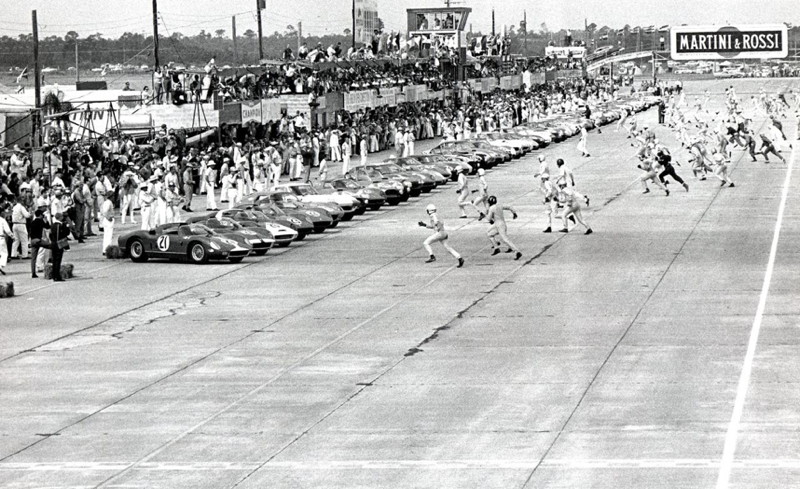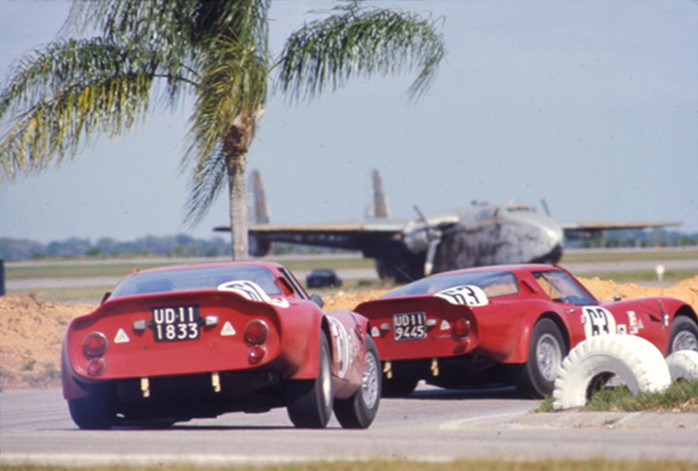Sebring and the FRC 2-Hours
Posted: Mon Mar 03, 2014 3:08 pm
Guys,
The 62nd running of the 12 Hours of Sebring starts at 10:15 am on Saturday, March 15th. This race is second only to the 24 Hours of Le Mans when it comes to famous endurance races that have withstood the passage of time. The first race was held on March 15th 1952, the same month and day of this year's race. Sebring is an airfield track much like our own (now lost) Wallerfield circuit and early versions used a combination of airstrips and access roads to form the track. The course has changed a bit over the years but still has airfield sections mixed in with the rest of the track.

Start of the 1964 race. Endurance races generally used the "Le Mans" type start in those days, with the drivers running to their cars at the drop of the flag. Those of you familiar with the Wallerfield circuit will immediatley recognise the wide runway comprised of slabs of concrete laid down in rows:

Alfa Romeo Giulia TZ2s at the 1966 Sebring 12 Hour GP:

Phil Hill, Lew Spencer and Ken Miles drove this Shelby Cobra roadster to 11th place and 1st in class at Sebring 1963

I expect that SPEED will air most if not all of the race, so be sure not to miss it.
So what's the significance of this at FRC? Well you should watch the race not just for the entertainment value, but also to prepare and get you in the mindset for an upcoming special event, the FRC 2-Hours Endurance. The race will be run according to the FRC Endurance Competition Regulations. Here's the proposed format:
Class:
The event will be for our Vintage Sports class to represent the historical aspect of endurance racing.
Race Length:
The race will be for two hour's duration (approximately 1,200 laps of FRC). SSDC race management software will keep track of the cars and the computer display will allow everyone to follow the race.
Number of Drivers:
Each car must have a minimum of two and a maximum of three drivers.
Establishing Driver Teams:
Entrants choose their teammate(s) prior to the event. This can be done right up to race day.
Race Qualifying:
Teams will draw for their qualifying slot (1st, 2nd, 3rd, etc.). Each team can decide how many of its members will qualify their officially entered car and the sequence they will do so within the team's qualifying slot. Qualifying will then be done in sequence individually over three flying laps. Each driver's best lap will be his qualifying time. De-slotted cars will be re-slotted to complete the three laps. Fastest time for each team determines the team's starting grid position, regardless of which team member does the first stint.
Mandatory Driver Changes:
Each team must do a minimum of five driver changes during the course of the race. Drivers completing a stint must record their driver change in the log provided.
Repairs:
Cars can be repaired if necessary during the course of the race.
I suggest you familiarise yourself with the FRC Endurance Competition Regulations upon which this event will be based.
So, are you ready to take on a real endurance race? Let's hear your thoughts below.
Gordon
The 62nd running of the 12 Hours of Sebring starts at 10:15 am on Saturday, March 15th. This race is second only to the 24 Hours of Le Mans when it comes to famous endurance races that have withstood the passage of time. The first race was held on March 15th 1952, the same month and day of this year's race. Sebring is an airfield track much like our own (now lost) Wallerfield circuit and early versions used a combination of airstrips and access roads to form the track. The course has changed a bit over the years but still has airfield sections mixed in with the rest of the track.

Start of the 1964 race. Endurance races generally used the "Le Mans" type start in those days, with the drivers running to their cars at the drop of the flag. Those of you familiar with the Wallerfield circuit will immediatley recognise the wide runway comprised of slabs of concrete laid down in rows:

Alfa Romeo Giulia TZ2s at the 1966 Sebring 12 Hour GP:

Phil Hill, Lew Spencer and Ken Miles drove this Shelby Cobra roadster to 11th place and 1st in class at Sebring 1963

I expect that SPEED will air most if not all of the race, so be sure not to miss it.
So what's the significance of this at FRC? Well you should watch the race not just for the entertainment value, but also to prepare and get you in the mindset for an upcoming special event, the FRC 2-Hours Endurance. The race will be run according to the FRC Endurance Competition Regulations. Here's the proposed format:
Class:
The event will be for our Vintage Sports class to represent the historical aspect of endurance racing.
Race Length:
The race will be for two hour's duration (approximately 1,200 laps of FRC). SSDC race management software will keep track of the cars and the computer display will allow everyone to follow the race.
Number of Drivers:
Each car must have a minimum of two and a maximum of three drivers.
Establishing Driver Teams:
Entrants choose their teammate(s) prior to the event. This can be done right up to race day.
Race Qualifying:
Teams will draw for their qualifying slot (1st, 2nd, 3rd, etc.). Each team can decide how many of its members will qualify their officially entered car and the sequence they will do so within the team's qualifying slot. Qualifying will then be done in sequence individually over three flying laps. Each driver's best lap will be his qualifying time. De-slotted cars will be re-slotted to complete the three laps. Fastest time for each team determines the team's starting grid position, regardless of which team member does the first stint.
Mandatory Driver Changes:
Each team must do a minimum of five driver changes during the course of the race. Drivers completing a stint must record their driver change in the log provided.
Repairs:
Cars can be repaired if necessary during the course of the race.
I suggest you familiarise yourself with the FRC Endurance Competition Regulations upon which this event will be based.
So, are you ready to take on a real endurance race? Let's hear your thoughts below.
Gordon